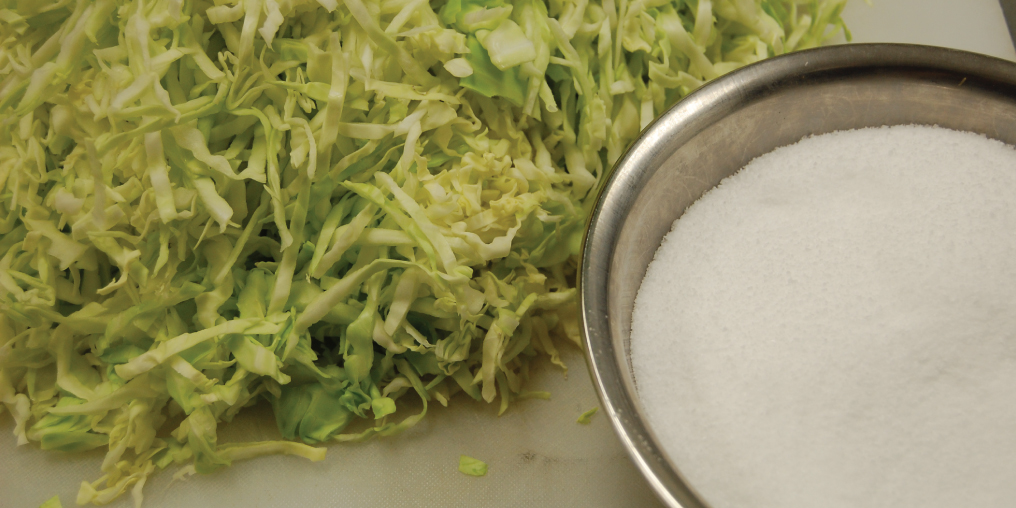I am willing to hazard that you enjoy the results of fermentation in some way, shape, or form. What I’m not going to do is assume that you’ve ever intentionally fermented anything. Sure, many of us have projects in the back of our refrigerator, but it seems that most folks leave the good work to the professionals: the brewers, the bakers, the picklers, and so on. I dabble in each of those crafts, and have learned that with a bit of attention and an ample amount of patience, anyone can achieve results equal to, or better, than what’s commercially available. It’s a magnificent process, and the massive scope of the subject is contained in many textbooks and pieces of paper passed down from generation to generation.. . I think there’s a fear of failure that prevents most people from delving deeper into fermentation at home. After all, our time and ingredients are precious. With that in mind, I’ve chosen what I believe to be the simplest possible project: homemade sauerkraut.
WHAT DO YOU NEED?
Green cabbage.
Salt of your choosing.
A clean bucket that is taller than it is wide.
A reasonably sharp knife, and maybe a mandolin (a slicing tool that is commonly used in professional kitchens).
HOW DO YOU DO IT?
1 That cabbage needs to be sliced thinly. In order to get there, I quarter the cabbage, which exposes a portion of the core to be easily removed with the knife.
2 From there you can use the knife to do the slicing, or a mandolin if you’ve got one. Thickness really comes down to personal preference, but I usually aim for a millimetre or two.
3 Now it’s time for that bucket to be put to use. Take a fistful of cabbage and squeeze your fists as though you’re trying to juice it. You’re rupturing cell walls, which will help that cabbage become kraut. Do this until you have a layer of cabbage, no more than a centimetre thick.
4 The only other ingredient here is the salt, and you’ll need to be liberal with it. It’s the preservative at work here, and will fend off the unwanted bacteria. You know how you might season a salad that you’ll eat immediately? Well use more salt than that. It should be salty, but not to the extent that you would consider using it on your sidewalk this winter.
5 Build your layers of cabbage and salt, pressing down firmly after each layer until you’ve run out of cabbage. Ideally your bucket is about two thirds full or less.
6 Have a beer, because it’s fermented and that will remind you of the good work you’re doing. Kimchi or Kombucha counts, too.
7 Apply a layer of plastic wrap to the surface of the eventual sauerkraut.
8 At this point, I like to apply pressure to further compact the cabbage and eliminate as much airspace as possible. To do that, I place the bucket in the sink, and put a garbage bag inside the bucket, on top of the plastic wrap. I fill that bag with water until I run out of space in the bucket, and tie a really awesome knot. This is the most effective way to achieve the goal, simply because it applies the pressure equally and completely.
9 This bucket of future goodness needs to sleep someplace cool and dark for a few weeks. A basement or closet would be great. You want to have it someplace that you’ll remember it. I recommend leaving it alone for at least four weeks, at that time you can use tongs to remove a sample and taste it. If there’s an acidity to balance the salinity, you’ve got sauerkraut, friend. You can leave it and monitor how the flavour changes over time (more funk), or you can transfer the batch into containers and store it in the fridge to stop that funk in its tracks.
10 Eat it! (with sausages, maybe.)
I could talk to you about fermentation all day, really. It’s a subject that is extremely broad, but worth examining if you’re even the slightest bit inclined. Reading will help you get better, or at least develop the confidence to start. For all things fermentation, look up Sandor Katz. If you want to brew, John Palmer is your man. If you want to know how to make exquisite bread, Chad Robertson will help you get there. In the absence of other humans with related experience, use Google.





